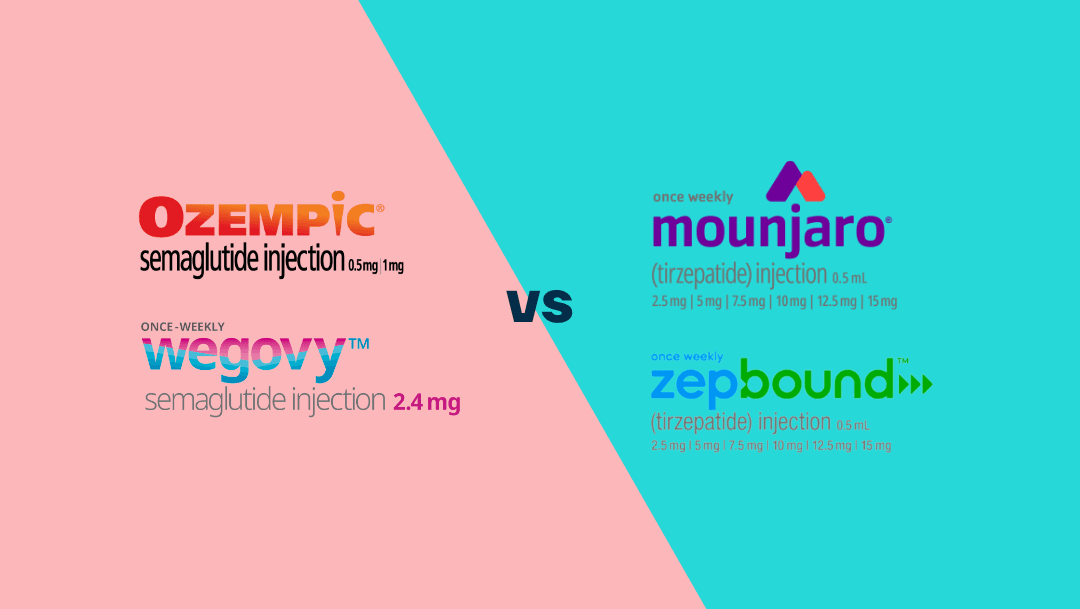What are tirzepatide and semaglutide?
Tirzepatide and semaglutide are drugs that mimic two hormones in the body that lowers hunger: GLP-1 and GIP.
The GLP-1 hormone has three major effects on your body:
- It slows the rate of food movement from your stomach to your small intestine
- It communicates with the appetite control centre in your brain, the hypothalamus, to increase satiety so you feel less hungry
- It manages the release of the insulin and glucagon hormones in your body, ultimately leading to lower blood sugar levels (generally a good thing)
The natural GLP-1 hormone in your body lasts only a few minutes, whereas the GLP-1 drugs can last for many days. This means they can have the above effects over a more sustained period.
All-in-all, this leads to people feeling less hungry because they have food in their stomach for longer, and GLP-1’s effect on the brain means that people feel like they have less ‘food noise’ and reduced cravings for highly desirable foods rich in added sugar.
The main difference between semaglutide and tirzepatide is that semaglutide mimics a single hormone, GLP-1, while tirzepatide mimics GLP-1 and GIP.
GIP is a hormone that supports blood sugar levels and helps our fat cells store more excess energy we might consume in our diets. Research also suggests GIP communicates with the brain similarly to GLP-1.
This dual-action effect of tirzepatide is thought to explain why better weight-loss results have been seen in the clinical trials published so far.
Tirzepatide and semaglutide dosing schedules
The other major difference between semaglutide and tirzepatide is the dosing schedules.
Semaglutide (Wegovy) has been approved for delivery at its maximum 2.4 mg dose, which is called its ‘maintenance’ dose.
To reach the maintenance dose level of 2.4 mg, you must take four ‘escalation’ doses over four months to reach the maximum dose.
The Wegovy dosing schedule looks like this:
Month 1 – 0.25 mg
Month 2 – 0.5 mg
Month 3 – 1 mg
Month 4 – 1.7 mg
Month 5 & onwards – 2.4 mg
The clinical licensing for semaglutide is clear, and increasing monthly doses is mandatory until the maximum 2.4 mg maintenance dose has been reached.
The other brand of semaglutide, Ozempic, has a slightly different dosing schedule, and patients are not required to rise through the escalation doses.
Patients have the flexibility to stay on lower doses if they’re meeting their blood sugar targets for type 2 diabetes.
The Ozempic dosing schedule looks like this:
Month 1 – 0.25 mg
Month 2 – 0.5 mg
Month 3 – 0.5 mg (up to 1 mg)
Month 4 – 0.5 mg (up to 1 mg)
Month 5 & onwards – 0.5 mg (up to 1 mg)
Tirzepatide is slightly different because it has 3 different maintenance doses: 5 mg, 10 mg, and 15 mg. This means there’s currently more flexibility with the dosing schedules of tirzepatide over semaglutide.
If people feel they are getting good weight-loss results at a lower maintenance dose of tirzepatide (e.g. 5 mg or 10 mg), they don’t need to increase their dose further.
Tirzepatide also has ‘escalation’ doses, which you’ll be required to take for four weeks if you decide to move up from one maintenance dose to another.
For example, if your current maintenance dose is 5 mg and you want to move up to a 10mg maintenance dose, you’ll need to spend 4 weeks on the 7.5 mg escalation dose.
If you wanted to go straight up to the maximum 15 mg dose of tirzepatide, this is what your titration plan would look like:
Month 1 – 2.5 mg
Month 2 – 5 mg
Month 3 – 7.5 mg
Month 4 – 10 mg
Month 5 – 12.5 mg
Month 6 & onwards – 15 mg
1) How do semaglutide and tirzepatide work?
When we eat food, our gut releases hormones that help the body regulate hunger and blood sugar levels. One of these hormones is GLP-1.
GLP-1 improves insulin function to lower blood sugar levels and delay gastric emptying, decreasing appetite.
GLP-1 also communicates with the brain’s appetite control centre, the hypothalamus, to lower food-seeking behaviour.
Another hormone released from the gut is GIP. GIP helps regulate blood sugar levels and helps our fat cells ‘absorb’ more energy from the bloodstream, which prevents fat from being stored in the liver or pancreas.
GIP also communicates with the brain and is believed to have a similar role to GLP-1 in lowering hunger.
So, both GLP-1 and GIP are hormones released in response to food and signal to the brain to lower hunger and food-seeking behaviours.
However, both hormones are removed from our blood quickly after being released. For example, after two minutes, 50% of the GLP-1 released from the gut in response to a meal is removed from the blood.
This short lifespan means that the effects of GLP-1 and GIP on lowering hunger are often short-lived.
How semaglutide works
Semaglutide is known as a GLP-1 receptor agonist as it mimics the actions of the hormone GLP-1. Semaglutide is about half as potent as the real GLP-1 hormone produced in the gut.
However, semaglutide has been developed to last longer in the blood and provide a sustained effect of lowering hunger, helping people eat less and lose weight.
After 4-5 weeks on semaglutide, the semaglutide in the blood reaches a level known as its ‘steady state’. This means its levels will be consistent and stable rather than rising and falling.
How tirzepatide works
Tirzepatide is also known as a GLP-1 receptor activator, as it mimics the actions of the hormone GLP-1. Tirzepatide is about a quarter as potent as the GLP-1 hormone produced by the gut.
However, tirzepatide has the additional function of mimicking the hormone GIP. Because of this additional action, tirzepatide is known as a dual-action GLP-1 and GIP receptor agonist.
Like semaglutide, tirzepatide is a long-acting medication. It takes 4-5 weeks for its active ingredient, tirzepatide, to reach a level in the blood we call its ‘steady state’ where its levels remain consistent and stable in the blood.
Key points:
- GLP-1 and GIP are hormones released by the body after we eat food
- They communicate directly with the brain to lower hunger and food-seeking behaviours
- Semaglutide is a single-action weight-loss injection and mimics the actions of the GLP-1 hormone
- Tirzepatide is a dual-action weight-loss injection and mimics the actions of the hormones GLP-1 and GIP
2) Do you lose more weight on semaglutide or tirzepatide?
Data from randomised controlled trials suggests that tirzepatide leads to more average weight loss than semaglutide.
One study found that tirzepatide supported an average weight loss of nearly 25% after one year. So, if you weighed 100 kg, that would be a 25 kg weight loss.
In comparison, research on semaglutide 2.4 mg suggests it supports an average weight loss of around 16% after one year, 9% less than tirzepatide.
Additionally, research suggests the percentage of participants on tirzepatide achieving more than 10% weight loss is considerably higher than semaglutide.
Achieving over 10% weight loss is associated with clinically significant reductions in risk of chronic conditions such as type 2 diabetes and heart disease.
A randomised controlled trial in 670 people showed that 92% of participants on tirzepatide achieved more than 10% weight loss, with 84% achieving more than 15%.
In comparison, a randomised controlled trial in 1,961 people showed that 69% of participants on semaglutide achieved more than 10% weight loss, with 50% achieving more than 15%.
So, research suggests that tirzepatide leads to more average weight loss than semaglutide and may support more people in achieving clinically significant weight loss of over 10%.
Key points:
- Research suggests tirzepatide supports more average weight loss after one year
- Average weight loss on tirzepatide after one year is around 25% and 16% on semaglutide
- Research shows more participants achieve more than 10% weight loss on tirzepatide (~90%) than semaglutide (69%)
3) Tirzepatide vs semaglutide: Which one should you choose?
Effectiveness
Tirzepatide is potentially more effective at supporting obesity and type 2 diabetes than semaglutide.
As demonstrated above, higher doses of tirzepatide appear to lead to greater weight loss and blood sugar reductions than semaglutide.
However, the highest doses of the two drugs haven’t been compared directly in double-blind, randomised controlled trials (the gold standard of medical research). So, we can’t say for sure which medication will prove more effective.
However, individual medication responses differ significantly, so it’s worth speaking with your healthcare provider to determine what would be best for you.
Side effects and safety
All medications have possible side effects, particularly if you live with other health conditions.
Some will be mild but uncomfortable, such as cramping, and others will be more severe, such as shortness of breath.
You must report any side effects to your doctor and healthcare team when taking medications.
Ttirzepatide seems more effective at weight loss than semaglutide, but earlier studies comparing it to semaglutide 1 mg suggested it had a slightly poorer safety profile.
In a randomised controlled trial with over 1800 participants comparing tirzepatide to semaglutide 1 mg, the tirzepatide group reported slightly more serious adverse events (5-7% VS 3%) and slightly higher discontinuation rates due to adverse events (6-8.5% VS 4%).
Additionally, there were more deaths in the tirzepatide group than in semaglutide (12 vs 1). However, the researchers noted they didn’t believe these deaths were linked to the medication.
Tirzepatide cost
Tirzepatide will cost £9.95 via prescription to the NHS in England. Privately, tirzepatide starts from £229 a month as part of Second Nature’s Mounjaro weight-loss programme.
Semaglutide cost
Semaglutide will cost £9.95 via prescription to the NHS in England. Second Nature’s Wegovy weight-loss programme also starts from £229 per month and is designed to match the price of our tirzepatide programme.
Key points:
- Tirzepatide is generally more effective than semaglutide at supporting weight loss and blood sugar reductions
- However, semaglutide may to lead to fewer side effects and is better tolerated than tirzepatide
- However, individuals will vary in their medication response, so choose the right one for you
- rBoth medications start from £229 per month with Second Nature
Take home message
Weight-loss injections are designed as additional tools for healthy lifestyle change and shouldn’t be considered lifelong medications.
Instead, they should be used to help you kickstart your weight-loss journey whilst you focus on building new, healthy habits.
Consider the use of antidepressants for people living with depression. They’re not designed to cure the condition. Instead, they’re designed to allow room for therapy to treat the condition’s underlying cause.
Tirzepatide and semaglutide are similar. These medications can help silence food-related thoughts and also give you a boost of confidence with more immediate weight-loss results.
This helps to buy you the time and headspace to understand why your body may have struggled to lose weight previously and to build new long-term healthy habits.
The core focus of our medication programmes is to calm down the feeling of food noise, lower your cravings, and allow you to build healthier habits to keep the weight off for good.
The ultimate goal is to make losing weight feel second nature.
Second Nature’s medication-supported programmes
Second Nature has two medication-supported programmes: a semaglutide weight-loss programme and a tirzepatide weight-loss programme.
If you’ve decided to try semaglutide or tirzepatide (assuming you’re eligible), why should you choose Second Nature over other medication providers?
For peace of mind.
Second Nature has worked with the NHS for over 6 years, providing weight-loss programmes across the UK.
Whilst our semaglutide and tirzepatide weight-loss programmes are private and not currently used by the NHS, we’ve built the programmes focusing on scientific evidence, patient safety, and data security.
We hope that our 6+ years of working with the NHS and building a track record of effective weight-loss results will give you peace of mind to give us a try.




